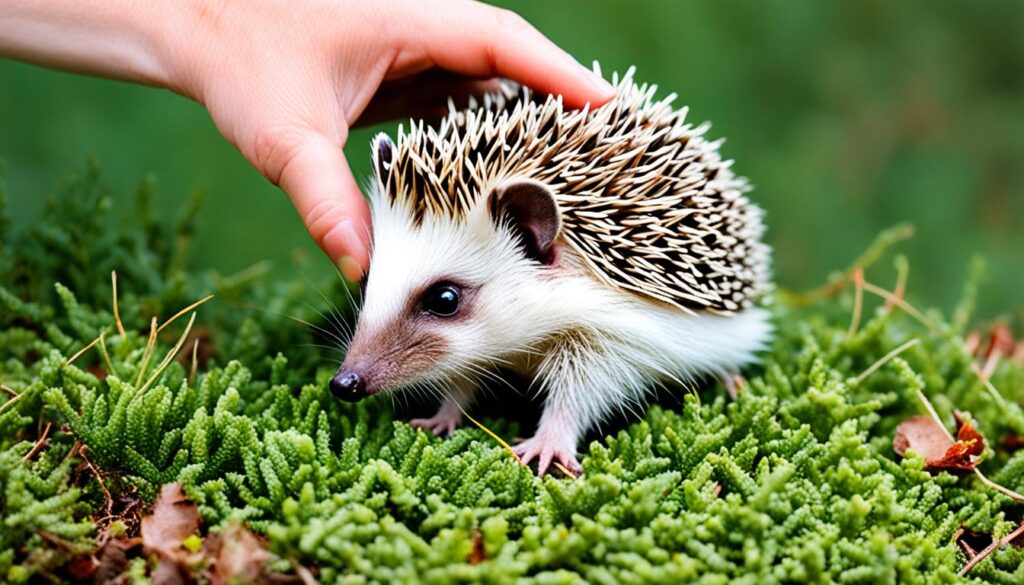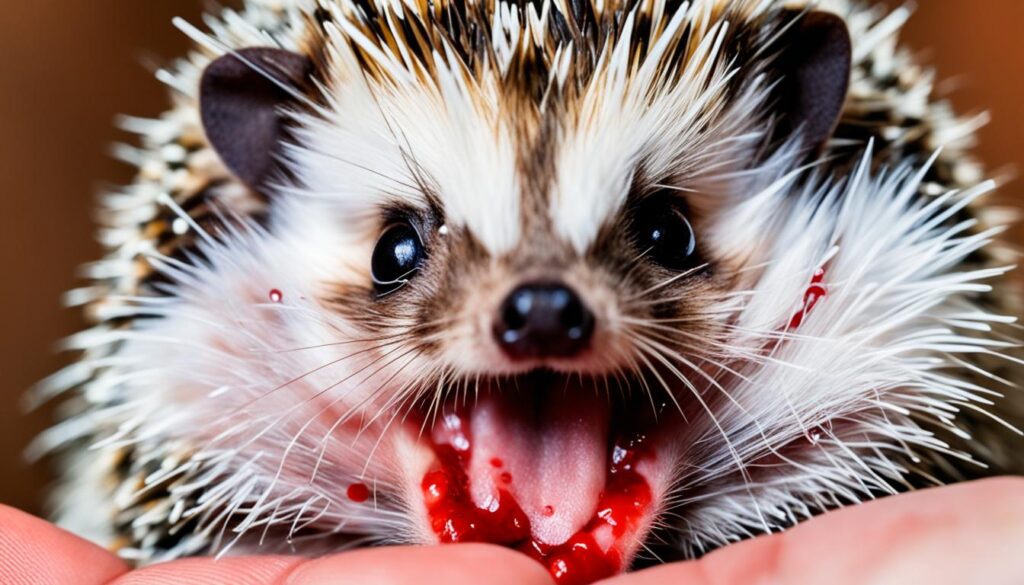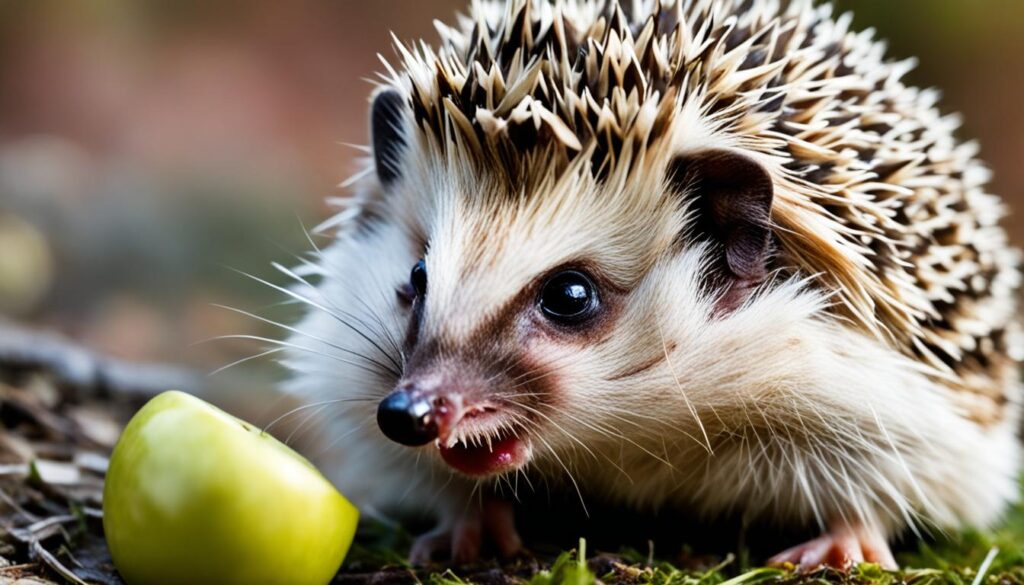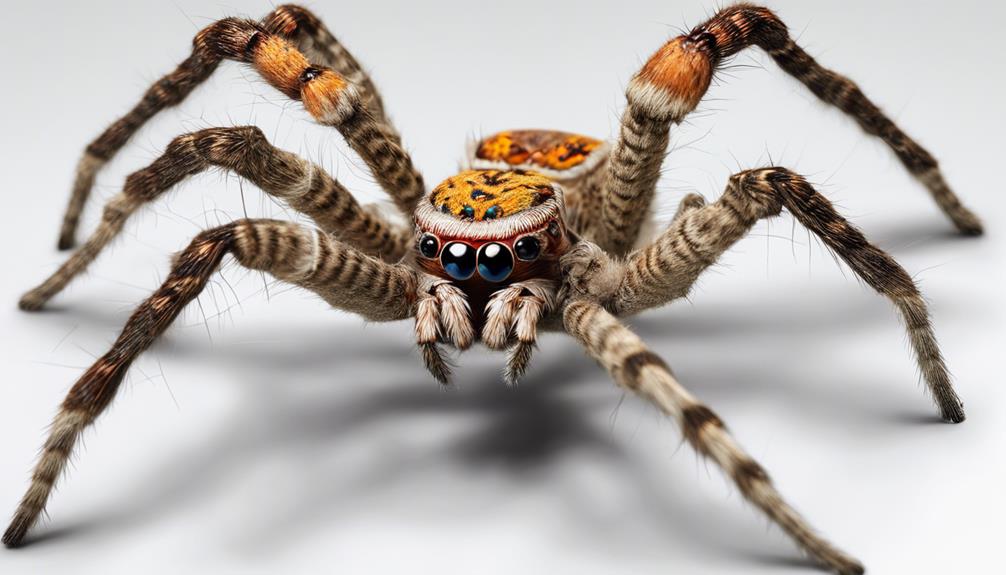Animal Facts
Do Hedgehogs Bite? Understanding Pet Safety

Did you know that hedgehogs have over 5,000 sharp needles on their backs? These adorable little creatures may seem harmless, but their spiky exterior can actually cause some discomfort. In addition to their prickly quills, hedgehogs also have a reputation for biting. So, before you bring home one of these enchanting pets, it’s essential to understand the risks and learn how to ensure their safety as well as your own.
Key Takeaways:
- Hedgehogs have sharp quills that can cause itching, rash, and discomfort when they come into contact with their owner’s skin.
- While hedgehogs can bite, it is rare and usually occurs when they are young or feel threatened.
- Understanding the reasons behind hedgehog biting behaviors and implementing appropriate training and handling techniques can reduce the likelihood of being bitten.
- Proper hygiene, such as handwashing and regular cleaning of their habitat, can help minimize the risk of contracting diseases from hedgehogs.
- By taking precautions and being observant of their behaviors, you can have a safe and enjoyable experience with your prickly pet.
Reasons For Hedgehog Bites
Hedgehogs are generally docile creatures, but there are several reasons why they may resort to biting. It is essential to understand these reasons to ensure a safe and harmonious interaction with your hedgehog.
Situations That May Trigger Hedgehog Bites:
- Feeling threatened or scared: Hedgehogs have a natural instinct to defend themselves when they feel threatened or frightened. If they perceive a potential danger, they may resort to biting as a means of protection.
- Experiencing pain or illness: A hedgehog in pain or discomfort may lash out and bite when approached or handled. It’s important to be aware of any signs of pain or illness in your hedgehog and seek appropriate veterinary care.
- Encountering strong smells or tastes: Hedgehogs rely heavily on their sense of smell, and strong odors or tastes on a person’s skin may trigger a defensive response, causing them to bite.
- Agitation or aggression: Like any living creature, hedgehogs can become agitated or aggressive, especially if they feel their boundaries are being invaded. Aggressive behaviors, such as snarling or hissing, may precede a bite.
- Protecting their territory: Hedgehogs are territorial animals and may bite if they feel their space is being invaded or threatened. They may perceive new people or animals as intruders and resort to biting as a protective measure.
Understanding the reasons behind hedgehog bites can help you anticipate potential triggers and take appropriate precautions to prevent biting incidents. By creating a safe and comfortable environment for your hedgehog and respecting their boundaries, you can foster a positive and trust-based relationship.
Recognizing Behaviors That Can Lead To Hedgehog Bites
When interacting with hedgehogs, it’s important to be aware of certain behaviors that may indicate a potential bite. By recognizing these behaviors, we can take the necessary precautions to prevent hedgehog bites and ensure our safety.
Body Language Indicators
Hedgehogs have unique body language cues that can give us insights into their mood and potential for biting. Some behaviors to watch out for include:
- Posturing stiffly: Hedgehogs may stand on their hind legs and puff up their quills when feeling threatened or defensive.
- Quick repositioning: If a hedgehog quickly changes its position to keep an eye on you, it may be signaling its wariness or discomfort.
- Aggression: Growling, hissing, or lunging are indicators of aggression and might be a precursor to biting.
- Search for an escape route: Hedgehogs may become restless and try to look for a way to escape if they feel cornered or trapped.
It’s crucial to familiarize ourselves with these body language cues to better understand the hedgehog’s feelings and respond accordingly. By respecting their boundaries and providing them with space when needed, we can minimize the risk of bites.
Signs of Discomfort or Distress
Hedgehogs that are experiencing pain, illness, or injury can be more prone to biting. As responsible caretakers, we should be observant of any signs of distress, such as:
- Unusual vocalizations: Whining, whimpering, or constant squealing could indicate discomfort or pain.
- Changes in eating or drinking habits: Loss of appetite, excessive thirst, or difficulty eating may suggest an underlying health issue.
- Lack of activity: If a normally active hedgehog becomes lethargic or loses interest in its surroundings, it could be a sign of illness.
- Visible injuries: Wounds, sores, or limping should be assessed and treated promptly to alleviate any pain or discomfort.
By being attentive to these indicators, we can address any potential health concerns and create a comfortable environment for our hedgehogs, thus reducing the likelihood of bites.
Creating a Safe Environment
Providing an appropriate habitat for hedgehogs can also contribute to their overall well-being and minimize the risk of aggressive behaviors. Here are some essential environmental considerations:
- Proper temperature and bedding: Maintaining suitable temperature levels and using appropriate bedding materials help hedgehogs feel comfortable and secure.
- Ample hiding spots: Hedgehogs need places to retreat and feel safe, such as tunnels, caves, or hideouts.
- Stress-free interactions: Avoid sudden movements, loud noises, or crowded environments that might startle or overwhelm the hedgehog.
By implementing these environmental factors, we can create a stress-free space where hedgehogs are less likely to feel threatened or resort to biting as a defense mechanism.
Overall, recognizing the behaviors and indicators that may lead to hedgehog bites is crucial for promoting a safe and enjoyable interaction with these delightful pets. By understanding their body language, being vigilant about signs of distress, and creating a suitable environment, we can foster a harmonious bond with our hedgie companions.
Ways To Handle Hedgehog Biting
When it comes to handling hedgehog biting, there are several effective techniques that can be employed. By understanding the reasons behind their biting behaviors and implementing appropriate strategies, we can ensure the safety and well-being of both ourselves and our prickly companions.
Avoidance: One of the key ways to handle hedgehog biting is through avoidance. By recognizing when a hedgehog is in a bad mood or needs space, we can give them the necessary distance. This allows the hedgehog to feel more secure and reduces the likelihood of them resorting to biting as a defensive mechanism.
Socialization: Building trust and reducing aggression is crucial in handling hedgehog biting. Socialization plays a vital role in achieving this. By gradually introducing hedgehogs to new experiences, people, and environments, we can help them feel more at ease and decrease their tendency to bite.
Diversion and Distraction: Redirecting a hedgehog’s attention away from biting can be achieved through diversion and distraction techniques. Providing them with engaging toys, tunnels, or puzzle feeders can keep their focus away from any potential biting situations.
Positive Reinforcement: Rewarding good behavior and discouraging biting through positive reinforcement is an effective technique. By offering treats or praise when a hedgehog displays non-biting behaviors, we encourage them to associate positive outcomes with gentle interactions.
Negative Punishment: While positive reinforcement is the preferred method, negative punishment can also be used to discourage biting behaviors when necessary. For instance, implementing a timeout by placing a hedgehog in a designated separate space for a short period of time can help them understand that biting leads to a loss of social interaction.
By employing these techniques, we can effectively handle hedgehog biting, prevent any potential harm, and maintain a positive relationship with our spiky companions.
| Technique | Description |
|---|---|
| Avoidance | Recognizing when a hedgehog needs space and giving them distance |
| Socialization | Building trust and decreasing aggression through gradual introductions |
| Diversion and Distraction | Redirecting the hedgehog’s attention away from biting using engaging toys or activities |
| Positive Reinforcement | Rewarding non-biting behaviors with treats or praise |
| Negative Punishment | Implementing a timeout as a consequence for biting |
Which Method Is Best For Stopping Hedgehog Bites?
When it comes to stopping hedgehog bites, it’s important to remember that different methods may work better for different hedgehogs. Each hedgehog is unique, and understanding their behaviors and preferences is key to finding the most effective approach. Here are some strategies to help you prevent hedgehog bites:
1. Socialization and Handling Techniques
Socializing your hedgehog from a young age can help build trust and reduce aggression. Handle your hedgehog gently and regularly, using positive reinforcement to reward good behavior. Gradually introduce your hedgehog to different environments, people, and situations to help them feel more comfortable and less likely to bite.
2. Diversion and Distraction
When you notice your hedgehog exhibiting signs of potential aggression or discomfort, try diverting their attention away from biting. Offer them a treat or engage them in an activity they enjoy, like playing with a toy or exploring a safe space. By redirecting their focus, you can help prevent biting behaviors.
3. Reinforcement Training
Positive reinforcement can be an effective training method for curbing biting behaviors. Reward your hedgehog with treats, praise, or playtime when they exhibit non-biting behaviors. This will help reinforce good behavior and discourage biting. Consistency is key in this training approach.
4. Identifying Triggers and Avoidance
Pay attention to your hedgehog’s reactions and behavior to identify triggers that may lead to biting. These triggers can vary from strong smells or tastes to feeling threatened or scared. Once you identify these triggers, take steps to avoid them or minimize their impact on your hedgehog. This may involve adjusting your handling techniques or creating a calm and secure environment for your pet.
Remember, the key to stopping hedgehog bites is observing, understanding, and respecting your hedgehog’s unique needs and preferences. Consistency and patience in implementing these methods will help you establish a safe and trusting relationship with your hedgehog.

Incorporating these effective methods into your interaction with hedgehogs can significantly reduce the risk of bites. By prioritizing your hedgehog’s comfort, using positive reinforcement, and recognizing potential triggers, you can create a safe and enjoyable environment for both you and your prickly companion.
Dealing With Hedgehog Bites In The Moment
If a hedgehog bites in the moment, remaining calm and responding appropriately is crucial for both your safety and the hedgehog’s well-being. The immediate focus should be on safely separating the hedgehog from the person it has bitten.
If there are any signs of injury, it is essential to provide immediate first aid. Proper first aid can help minimize the risk of infection and promote healing. However, if the bite is severe or shows signs of infection, seeking medical attention is highly recommended.
While treating the bite, it is equally important to carefully observe the hedgehog for any signs of distress or injury. Hedgehogs may exhibit behaviors like whimpering, excessive drooling, or difficulty moving if they are injured. Being vigilant and attentive can help determine if further veterinary assistance is required.
Remember, hedgehog bites are rare, and it’s crucial to approach the situation with a calm mindset and take appropriate actions to ensure the safety and well-being of both parties involved.
| First Aid Steps for Hedgehog Bites: |
|---|
| 1. Wash the bite area gently with mild soap and warm water. |
| 2. Apply an antiseptic solution, like hydrogen peroxide, to the wound. |
| 3. Cover the bite with a clean bandage or sterile dressing. |
| 4. Monitor the wound for signs of infection (increased redness, swelling, pus, or fever). |
| 5. Seek medical attention if the bite is deep, shows signs of infection, or if you are unsure about proper wound care. |

Straight Talk About Hedgehog Bites
Hedgehog bites may not be a common occurrence, but it’s important to be prepared and take necessary precautions when handling these adorable creatures. By understanding the reasons behind their biting behaviors and implementing appropriate training and handling techniques, you can greatly reduce the likelihood of being bitten. Consistency and patience are key in promoting a safe and enjoyable interaction with hedgehogs.
Here are some important facts and considerations to keep in mind:
- Hedgehog bites are not common behaviors: While many hedgehogs are gentle and rarely bite, it’s essential to remember that they are still wild animals at their core. They have natural instincts and behaviors that may occasionally manifest as a bite.
- Preventing hedgehog bites: To minimize the risk of bites, it’s crucial to handle hedgehogs with care and respect. Always approach them calmly and avoid sudden movements. Provide a conducive environment and avoid situations that may cause stress or fear.
- Understanding biting behaviors: Hedgehogs may bite when they feel threatened, anxious, or hurt. By observing their body language and listening to their vocal cues, you can learn to recognize the warning signs and adjust your interactions accordingly.
- Proper training and handling: Consistent training is essential in establishing trust and building a positive relationship with your hedgehog. Use gentle handling techniques, provide regular socialization, and employ positive reinforcement to encourage desired behaviors.
Remember, when it comes to hedgehog bites, prevention is the key. By taking appropriate measures, respecting their boundaries, and building trust, you can enjoy a safe and rewarding experience with these fascinating creatures.
Handling Techniques to Prevent Hedgehog Bites
| Technique | Description |
|---|---|
| Avoidance | Giving hedgehogs space when they are in a bad mood or showing signs of distress. Respecting their boundaries and avoiding situations that may cause anxiety or fear. |
| Socialization | Regularly interacting with your hedgehog in a positive and calm environment. This helps build trust and reduce aggression. |
| Diversion and Distraction | Redirecting a hedgehog’s attention away from potential triggers that may lead to biting. Offering toys or treats can help divert their focus. |
| Positive Reinforcement | Rewarding good behavior with treats or praise to encourage desired actions and discourage biting. |
| Negative Punishment | Using timeout or withdrawal of attention as a consequence for biting behavior. Consistency is crucial in reinforcing the message that biting is not acceptable. |
By implementing these handling techniques and being attuned to your hedgehog’s needs, you can create a harmonious bond and reduce the likelihood of bites.

Conclusion
In conclusion, while hedgehogs have the potential to bite, it is a rare occurrence. By understanding the reasons behind their biting behaviors and implementing appropriate strategies, we can help prevent bites and ensure pet safety. It is important to handle hedgehogs with care, using gloves for protection, and practicing good hygiene to minimize the risk of infection. Moreover, being observant of their behaviors and learning their body language can help create a positive and enjoyable bond between hedgehog and owner.
By taking proper precautions, such as avoiding situations that may agitate or frighten the hedgehog, we can have a safe and fulfilling experience with these adorable prickly pets. Remember, consistency, patience, and positive reinforcement are key in training hedgehogs to reduce biting behaviors. Together, we can foster a loving and trusting relationship with our hedgehog companions.
So, if you’re considering a hedgehog as a pet, don’t let the fear of biting deter you. With knowledge, understanding, and responsible pet ownership, we can create a harmonious and safe environment for both ourselves and our hedgehog friends. Happy hedgehog parenting!FAQ
Do hedgehogs bite?
What are the reasons for hedgehog bites?
How can I recognize behaviors that may lead to hedgehog bites?
What are some ways to handle hedgehog biting?
Which method is best for stopping hedgehog bites?
How should I respond to hedgehog bites in the moment?
Are hedgehog bites common?
What is the key takeaway about hedgehog bites?
Is a Hedgehog’s Unique Traits Related to Their Tendency to Bite?
Understanding hedgehog unique traits is crucial when it comes to their tendency to bite. Hedgehogs may bite due to fear, feeling threatened, or unease. Their quills and nocturnal habits are unique traits that can impact their behavior. Proper handling and creating a safe environment can reduce the likelihood of bites.
Source Links
- https://homeandroost.co.uk/blog/hedgehogs-and-dogs/
- https://heavenlyhedgies.com/help-my-hedgehog-bites-me/
- https://www.hornbeamwood.org.uk/post/are-hedgehogs-dangerous-humans-bite-flees-ringworm-ticks-noises-spines-hiss-bacteria
Dana is our Lead Content Writer, bringing a wealth of knowledge and expertise to our team. With a background deeply rooted in animal studies and a profound love for all creatures, Dana is dedicated to crafting engaging and informative content that resonates with our audience. With Dana at the helm, you can trust that our content is accurate and engaging, catering to the diverse interests of animal enthusiasts everywhere.

Animal Facts
5 Fascinating Animals Without Tails
Get ready to explore the world of tailless wonders with gorillas, chimpanzees, and more mysterious creatures that will leave you in awe.

Prepare to be impressed by animals that break the norm by thriving without tails. From tailless primates such as gorillas and chimpanzees with intricate social structures to intelligent dolphins displaying their playful nature, these creatures are sure to captivate your attention.
Pangolins covered in protective scales and facing endangerment, gentle manatees gracefully traversing waters, and spiders showcasing intricate adaptations are also part of this tailless wonders list. Stay tuned to discover more fascinating details about these incredible tailless animals.
Key Takeaways
- Dolphins are highly intelligent creatures with no tails, known for complex problem-solving skills and communication abilities.
- Pangolins, covered in protective scales, face extinction due to illegal poaching, making conservation efforts crucial.
- Manatees, gentle herbivores without tails, are vulnerable to threats like boat strikes and habitat loss, requiring protection.
- Spiders, diverse arachnids, use silk for web-building and prey capture, showcasing unique adaptations and intricate behaviors.
- Primates like gorillas and chimpanzees are tailless, displaying remarkable intelligence and complex social behaviors.
Primates
In the domain of tailless animals, primates stand out for their remarkable intelligence and intricate social dynamics. Tailless primates, such as gorillas, chimpanzees, bonobos, and orangutans, showcase a myriad of complex social behaviors that mirror our own. The absence of a tail in primates has driven their evolution towards bipedal locomotion, allowing for upright posture, which has further facilitated their tool use for problem-solving. These fascinating creatures have adapted to diverse environments in Africa and Southeast Asia, demonstrating their resilience and versatility.
Among the tailless primates, gibbons are particularly known for their acrobatic abilities and distinctive vocalizations in the wild. Their swinging prowess through the treetops is a sight to behold. Additionally, primates without tails engage in various behaviors, from intricate grooming rituals that strengthen social bonds to establishing complex social hierarchies within their groups. Observing these intelligent creatures navigate their social worlds offers a glimpse into the intricate tapestry of relationships and behaviors that define their existence.
Dolphins

Dolphins, renowned for their intelligence and social nature, possess a unique horizontal fluke for propulsion instead of a visible external tail. These marine mammals exhibit intriguing behavior and engage in intricate social interactions that fascinate observers worldwide.
Here are some fascinating facts about dolphins:
- Dolphins are highly intelligent creatures, displaying complex problem-solving skills and communication abilities.
- Their playful behavior often involves riding waves, leaping out of the water, and engaging in games with other dolphins.
- Social interactions among dolphins are essential for their survival, as they rely on cooperation and communication within their pod.
- The horizontal fluke of dolphins serves as a powerful propulsion mechanism, allowing them to move swiftly and gracefully through the water.
Through the combination of their streamlined bodies, powerful muscles, and unique fluke structure, dolphins showcase efficient swimming techniques and remarkable acrobatic prowess, making them truly captivating marine animals.
Pangolins
Gracefully gliding through their habitats, pangolins captivate with their unique features and behaviors. These unique mammals are covered in protective keratin scales, making them resemble walking artichokes. Their long, sticky tongues are perfectly adapted for capturing ants and termites, their favorite delicacies.
Unfortunately, pangolins are facing a grave threat – illegal poaching. The demand for their scales and meat has pushed them to the brink of extinction, with all eight species, spread between Africa and Asia, endangered.
Conservation efforts are paramount in safeguarding these fascinating creatures. Initiatives to combat the illegal wildlife trade are essential for the survival of pangolins. Raising awareness about the plight of these gentle animals is vital, as is enforcing stricter laws to protect them. Without immediate action, pangolins may disappear from the wild forever.
It's up to us to make sure that these marvelous creatures continue to roam our forests and savannas, adding their unique charm to the tapestry of nature.
Manatees

Swimming gracefully through the coastal waters and rivers of tropical and subtropical regions, manatees, also known as sea cows, are large, herbivorous marine mammals with distinctive paddle-like flippers and a rounded, tailless body shape. These gentle giants captivate with their unique features and behaviors:
- Gentle Herbivores: Manatees have a peaceful nature, feeding on aquatic plants in their watery habitats.
- Slow-Moving Giants: Despite their size, manatees move gracefully and slowly through the water.
- Vulnerable Creatures: Due to their gentle demeanor and slow movements, manatees are susceptible to threats like boat strikes.
- Conservation Concerns: Ongoing efforts to protect manatees and their habitats from dangers like habitat loss and human activities.
Manatees, with their endearing characteristics and vulnerable status, remind us of the importance of safeguarding these magnificent marine mammals through dedicated conservation initiatives.
Spiders

Intriguing for their arachnid characteristics, spiders captivate with their diverse species and unique adaptations for survival in various habitats.
Spiders, belonging to the arachnid family, are renowned for their eight legs and the absence of a tail. They produce silk for various purposes, including web-building, prey capture, and constructing shelters. Utilizing venom to subdue their prey, spiders possess specialized hunting techniques that vary among species.
Some spiders exhibit intricate mating behaviors and display remarkable parental care, a surprising trait for creatures often associated with solitude. Despite their lack of a tail, spiders thrive in diverse environments, showcasing a remarkable array of adaptations.
From the intricate webs of orb-weavers to the stealthy ambush tactics of jumping spiders, each species contributes uniquely to the intricate tapestry of the natural world. The world of spiders is a fascinating domain where survival, reproduction, and innovation intersect in enthralling ways.
Frequently Asked Questions
What Kind of Animals Have No Tails?
We explore tailless animals like snakes, turtles, birds, apes, and whales. Taillessness can stem from various reasons like evolution, specialized movement, balance needs, environment factors, or survival benefits. These creatures display unique traits and habitats.
What Animal Has 4 Legs but No Tail?
We found an animal that has four legs but no tail. It's the Manx cat! This unique breed boasts a genetic mutation giving it a tailless charm. Despite lacking a tail, Manx cats are playful, affectionate, and agile.
Why Capybara Doesn T Have a Tail?
We don't have tails because we're capybaras, adapted herbivores thriving in wetlands. Our taillessness is natural, not a mutation or injury. We use strong social bonds and swimming skills to compensate effectively.
What Rodent Does Not Have a Tail?
It's common knowledge that the Tiliqua rugosa, a captivating rodent indigenous to Australia, lacks a tail. However, this tailless skink's distinctive adaptation of utilizing its stubby tail as a fat reserve demonstrates its incredible survival skills and adaptability.
Are Any of the Animals Without Tails in the List of Nature’s Oddities?
When unveiling nature’s oddities, it’s interesting to note that some animals are indeed tailless. Examples include the Manx cat, some breeds of dogs such as the Australian Stumpy Tail Cattle Dog, and certain species of lizards and insects. These tailless creatures definitely stand out in the animal kingdom.
Conclusion
To sum up, these tail-less creatures showcase the diverse adaptations found in the animal kingdom.
From the agile primates swinging through trees to the graceful dolphins gliding through the water, each species has evolved unique ways to thrive without a tail.
Observing these fascinating animals in their natural habitats provides a vivid glimpse into the intricate web of life on Earth, where every creature plays a crucial role in the ecosystem's balance.
Paul’s love for animals knows no bounds. As a dedicated writer and animal lover, Paul brings a unique perspective to our team. His firsthand experiences with various animals enrich our content and provide valuable insights into their behavior and needs. Whether he’s sharing tips for pet care or shedding light on pressing conservation issues, Paul’s passion for animals shines through in everything he does.
Animal Facts
Animals That Live in a Lake: Exploring Aquatic Wildlife
Prepare to be captivated by the diverse and colorful aquatic wildlife in lakes, from graceful pelicans to mysterious pike – a fascinating world awaits!

We discovered a range of fascinating aquatic animals that thrive in lakes. Among them are the adaptable ducks with webbed feet, the crucial lake trout in North American ecosystems, and the vibrant flamingos that add color to lakeshores. These creatures are important for biodiversity and help to keep the delicate balance of freshwater environments.
Explore further to uncover more about the enchanting wildlife that calls lakes home.
Key Takeaways
- Ducks with webbed feet are well-adapted to lake life.
- Lake trout are crucial in North American lake food chains.
- Salamanders play a significant role in lake ecosystems.
- Flamingos bring colorful beauty to lakeshores.
- Lakes host a diverse array of thriving freshwater life.
Freshwater Lake Animals
Freshwater lakes harbor a remarkable diversity of aquatic fauna, encompassing 41% of fish species and a myriad of unique animals such as beavers, frogs, electric eels, hurons, and dragonflies.
These animals play essential roles in the freshwater ecosystem, each adapted to live in the specific conditions provided by the lakes. Fish species like trout and bass thrive in the clear waters, while beavers construct intricate dams that shape the landscape.
Frogs can be spotted near the water's edge, their calls echoing through the tranquil surroundings. Electric eels, though elusive, add a spark to the underwater world with their unique abilities.
Hurons, with their graceful movements, navigate the waters effortlessly, preying on smaller fish. Dragonflies flit about, adding splashes of color to the lakeside scenery. Together, these animals create a vibrant tapestry of life within freshwater lakes, highlighting the intricate interconnectedness of this aquatic habitat.
Saltwater Lake Animals

In saltwater lakes, an array of fish species, such as clownfish, grouper, and pufferfish, thrives amidst the crucial salinity environment, showcasing unique adaptations for survival. These creatures have evolved specialized mechanisms to regulate their internal salt levels, enabling them to live in waters that would be inhospitable to many other freshwater animals. The table below highlights some of the fascinating saltwater lake animals and their distinctive features:
| Saltwater Lake Animals | Unique Adaptations | Habitat |
|---|---|---|
| Clownfish | Ability to live among sea anemones | Coral reefs |
| Grouper | Camouflaging techniques | Rocky crevices |
| Pufferfish | Inflating when threatened | Sandy bottoms |
Saltwater lakes provide crucial ecosystems for these fish species and many others, contributing to the rich marine biodiversity found in these unique habitats. The interactions between these animals and their environment shape the delicate balance of life in saltwater and freshwater habitats, highlighting the importance of preserving these aquatic ecosystems for future generations.
Semiaquatic Animals
Semiaquatic animals, encompassing amphibians, reptiles, and select mammals, navigate their existence in both terrestrial and aquatic domains, showcasing a diverse array of adaptations tailored to their dual habitat lifestyle.
River otters, with their streamlined bodies and webbed feet, elegantly glide through freshwater habitats, preying on fish and crustaceans while also foraging on land.
Painted turtles, known for their colorful shells, bask on logs in the sun to regulate body temperature before gracefully swimming to hunt for aquatic plants and small invertebrates.
Water snakes, equipped with bony plates for buoyancy and powerful muscles for swimming, stealthily patrol the shallows, preying on fish and amphibians.
Aquatic salamanders, such as the spotted salamander, exhibit fascinating larval stages in water before metamorphosing into adults that navigate both land and water, contributing to the intricate food webs of lake ecosystems.
These semiaquatic species play crucial roles in maintaining the delicate balance of freshwater ecosystems, highlighting the interconnectedness of life both above and below the water's surface.
Animals That Live in a Lake

Ducks, lake trout, salamanders, flamingos, and various other species populate lakes worldwide, forming diverse and intricate ecosystems. Ducks, with their distinctive webbed feet, are well-adapted to freshwater habitats. Lake trout, known for their pivotal role in the food chain of North American lakes. Salamanders, often overlooked, contribute substantially to the balance of lake ecosystems by regulating insect populations and serving as prey for larger predators. In contrast, flamingos add a splash of color to lakeshores, feasting on small crustaceans with their uniquely curved bills.
These aquatic wildlife species showcase the rich tapestry of life that thrives in freshwater environments. Each species holds a specific place within the intricate web of interactions that sustain the delicate balance of lake ecosystems. From the graceful movements of ducks gliding across the water to the stealthy hunt of lake trout lurking in the depths, these diverse inhabitants collectively shape the dynamic nature of lakes around the world.
What Do Animals That Live in Lakes Eat?

Among the diverse array of animals inhabiting lakes worldwide, their dietary preferences encompass a wide range of foods, including:
- Fish: Predatory fish such as pike and bass dominate the food chain, preying on smaller fish and invertebrates for sustenance. These important fish species play a critical role in regulating the lake's ecosystem by controlling the population of other aquatic creatures.
- Insects: Various insects serve as a crucial food source for many lake-dwelling animals, including fish, birds, and amphibians. Mosquito larvae, for example, are a favorite snack for fish like bass, contributing to the delicate balance of the lake's food web.
- Aquatic Plants: Herbivorous animals like ducks and swans rely on aquatic plants and algae as their primary diet. Grazing on these plant species not only sustains these herbivores but also helps in controlling the growth of vegetation within the lake.
- Small Mammals: Some lakes are home to small mammals like muskrats and otters that feed on a variety of foods, including fish, crustaceans, and aquatic plants. These omnivorous creatures play a significant role in shaping the biodiversity of the lake environment.
Frequently Asked Questions
What Type of Animals Live in the Lake?
We observe a variety of animals in lakes – from fish like trout and pike to diverse wildlife such as beavers, ducks, and dragonflies. These creatures interact within the lake ecosystem, showcasing a delicate balance of life.
What Are the Animals That Live in the Water?
In the water, we find a diverse array of animals such as fish, turtles, and frogs. They thrive in aquatic environments, adapting to the challenges and opportunities presented by lakes, rivers, and oceans.
What Kind of Marine Life Lives in Lake Michigan?
In Lake Michigan, over 30 fish species like lake trout, salmon, and yellow perch thrive. The ecosystem also includes freshwater mussels, crayfish, and algae. Birds such as seagulls, ducks, and cormorants contribute to the lake's biodiversity. Invasive species like zebra mussels and round gobies impact the native marine life.
What Kind of Animals Live in a Pond?
In ponds, diverse creatures like frogs, turtles, dragonflies, and fish thrive. Birds, including ducks and herons, flock for food and nesting. Aquatic plants offer shelter and sustenance. Ponds, akin to bustling cities, teem with life, interconnected in a delicate ecosystem.
What Kind of Aquatic Wildlife Can Be Found in Mountain Lakes?
When exploring mountain lakes, you might spot a variety of aquatic creatures. From elusive freshwater fish like the golden trout to amphibians like the American dipper, the alpine mountain wildlife guide is filled with fascinating creatures. Keep an eye out for otters, beavers, and even rare dragonflies in these high altitude lakes.
Conclusion
To sum up, the diverse array of animals that live in lakes showcases the incredible adaptability and resilience of aquatic wildlife.
From freshwater to saltwater environments, these creatures have evolved unique characteristics to thrive in their watery habitats.
By understanding what these animals eat and how they interact with their surroundings, we can gain a deeper appreciation for the intricate ecosystem of lakes and the crucial role these creatures play in maintaining balance and harmony within their underwater world.
Paul’s love for animals knows no bounds. As a dedicated writer and animal lover, Paul brings a unique perspective to our team. His firsthand experiences with various animals enrich our content and provide valuable insights into their behavior and needs. Whether he’s sharing tips for pet care or shedding light on pressing conservation issues, Paul’s passion for animals shines through in everything he does.
Animal Facts
What Animal Looks Most Like a Squirrel?
Uncover fascinating creatures resembling squirrels, from chipmunks to marmots and prairie dogs, showcasing unique similarities and connections in the animal kingdom.

When searching for animals that resemble squirrels, creatures such as chipmunks, marmots, and prairie dogs are among the top contenders. Chipmunks are small with striped patterns and bushy tails, famous for storing food like squirrels. Marmots are larger ground-dwelling rodents with furry coats and bushy tails, some growing up to 2 feet in size. Prairie dogs, especially the Black-tailed and Gunnison’s species, with their underground burrows and social nature, also display squirrel-like features. These animals demonstrate behaviors and physical traits similar to squirrels, highlighting their interconnectedness in ecosystems.
If you're intrigued by these similarities, there's more to uncover about other rodents resembling squirrels and exotic pets with squirrel-like features.
Key Takeaways
- Chipmunks share squirrel-like features with distinctive stripes and bushy tails.
- Marmots resemble squirrels in size and bushy tails, with burrowing habits.
- Black-tailed Prairie Dogs exhibit squirrel-like characteristics in appearance and behavior.
- Rodents like marmots, chipmunks, and prairie dogs show similarities to squirrels.
- Exotic pets like Sugar Gliders and Chinchillas have features akin to squirrels for unique options.
Chipmunks: The Squirrel Lookalikes
Chipmunks, small rodents closely resembling squirrels in appearance and behavior, exhibit a striking resemblance that extends beyond their physical attributes to their nesting habits and foraging techniques. These creatures, part of the squirrel family, boast bushy tails and distinctive striped patterns akin to tree squirrels. While their tails are shorter, chipmunks share the squirrel's propensity for food caching, storing nuts and seeds for later consumption. Nest builders by nature, some chipmunk species, such as the Lodgepole Chipmunk, construct intricate burrows for shelter and protection.
What sets chipmunks apart is their adept climbing skills, effortlessly maneuvering through trees much like their squirrel cousins. Observing these small mammals scurrying up branches with agility is a reflection of their evolutionary adaptations. The similarities between chipmunks and tree squirrels aren't merely superficial; they run deep in their genetic makeup and behavioral patterns. Studying these tiny creatures provides a fascinating glimpse into the interconnectedness of nature within the squirrel family.
Marmots: Nature's Squirrel Twins

Closely resembling squirrels in appearance and behavior, marmots are larger ground-dwelling rodents known for their furry coats and bushy tails. These creatures, akin to tree squirrels, exhibit striking physical similarities, making them nature's squirrel twins.
Marmots, with their penchant for constructing underground burrows like their squirrel counterparts, engage in behaviors such as food caching and alarm calls. The Hoary Marmot, a notable species, can reach impressive sizes of up to 2 feet in length and weigh as much as 8 pounds, mirroring the stature of large squirrels.
Through their shared evolutionary history and habitat preferences, marmots and squirrels have intertwined proofs, standing as evidences to the wonders of nature's design. The evolutionary parallels between these ground-dwelling rodents and arboreal squirrels provide a fascinating glimpse into the intricate tapestry of the animal kingdom, where similarities in form and function blur the lines between species.
Prairie Dogs: Squirrel Impersonators
Resembling squirrels both in appearance and behavior, prairie dogs are intriguing creatures that exhibit striking similarities to their arboreal counterparts. These social herbivores, such as the black-tailed and Gunnison's species, dwell in underground burrows akin to squirrel nests. The black-tailed prairie dogs sport small frames complemented by long tails, while their Gunnison's counterparts boast larger bodies with bushy tails and elongated hind legs. Utah prairie dogs, another member of this squirrel impersonator group, feature petite sizes and fluffy tails, sharing a penchant for burrowing just like squirrels.
Observing prairie dogs in their natural habitat reveals their communal nature and herbivorous diet, further mirroring squirrel behavior. The intricate network of burrows they create underground not only serves as shelter but also as a hub for social interactions, much like squirrel communities in trees. With their distinct physical attributes and lifestyle choices, prairie dogs stand out as fascinating creatures that closely resemble squirrels in various aspects.
Rodents Resembling Squirrels

In the domain of rodent species sharing similarities with squirrels, marmots stand out for their substantial size and burrowing habits akin to those of tree-dwelling squirrels. These hoary marmots, also known as Alaska marmots, are commonly found in rocky slopes, echoing the habitats favored by many squirrel species. The marmot's resemblance to squirrels extends beyond their living arrangements, encompassing aspects of their physical appearance and behaviors.
Chipmunks, especially species like the Lodgepole chipmunks, Least Chipmunk, and Colorado chipmunk, exhibit striking similarities to squirrels with their small size, distinctive stripes, and cheek pouches for storing food. These traits closely mirror those of ground squirrels, further blurring the line between the two groups. Additionally, the Black-Tailed Prairie Dog shares squirrel-like characteristics such as a social nature, herbivorous diet, and preference for underground dwellings, reinforcing the interconnectedness of rodents resembling squirrels in various ecosystems.
Exotic Pets With Squirrel-Like Features

Observing the spectrum of exotic pets with squirrel-like features reveals a fascinating array of creatures that share intriguing resemblances to these nimble arboreal mammals. Among these fascinating animals are sugar gliders, Siberian chipmunks, chinchillas, and African dormice. These creatures offer unique pet options with similarities to squirrels, making them popular choices among enthusiasts.
| Exotic Pets | Resemblance to Squirrels | Unique Features |
|---|---|---|
| Sugar Gliders | Tree-dwelling marsupials with skin flaps for gliding | Active in the night |
| Siberian Chipmunks | Active during the day and live in trees | Not native to N.America |
| Chinchillas | Energetic and curious personalities similar to squirrels | Found in the Andes mountains |
| African Dormice | Small rodents with bushy tails resembling squirrels | Once popular pets in the U.S. |
These animals exhibit behaviors and physical traits that echo the charm and allure of squirrels, offering a unique experience for those looking to bring a touch of the wild into their homes.
Frequently Asked Questions
Which Animal Looks Like Squirrel?
We often observe animals resembling squirrels in various ways. From chipmunks with their stripes to prairie dogs' social behavior, and marmots' burrowing habits, nature presents a tapestry of creatures echoing the squirrel's traits.
What Animal Is Most Closely Related to Squirrels?
We observe marmots, close relatives of squirrels within the Sciuridae family. They share an evolutionary history dating back to the late Miocene Epoch. Physical traits and behaviors of marmots bear striking resemblances to squirrels, emphasizing their kinship.
What Is the Closest Thing to a Squirrel?
Well, the closest thing to a squirrel? Chipmunks! Those cheeky little critters with their food-stashing ways. They're like the squirrel's quirky cousin. Watch them scurry and stash, nature's little comedians.
What Rodent Looks Like a Small Squirrel?
We observed the question about a rodent resembling a small squirrel. The Lodgepole Chipmunk with its striped back, the Hoary Marmot's stout body, moles' velvety fur and paddled feet, and hamsters' short tails share similarities with squirrels.
Are Red Pandas Related to Squirrels in Any Way?
Yes, recognizing red panda behavior can offer some insight into their relationship with squirrels. While red pandas and squirrels are not closely related, they do share similar arboreal habitats and both are known for their agile climbing and tree-dwelling behaviors.
Conclusion
In the vast tapestry of the animal kingdom, we've uncovered creatures that mirror the charming squirrel in appearance and behavior.
From the chipmunks with their striped coats, to the marmots with their bushy tails, and even the prairie dogs with their social habits, nature has painted vivid portraits of squirrel doppelgangers.
These animals serve as reminders of the beauty and diversity that exist within our world, each one a unique thread in the intricate fabric of life.
Paul’s love for animals knows no bounds. As a dedicated writer and animal lover, Paul brings a unique perspective to our team. His firsthand experiences with various animals enrich our content and provide valuable insights into their behavior and needs. Whether he’s sharing tips for pet care or shedding light on pressing conservation issues, Paul’s passion for animals shines through in everything he does.
-

 Vetted2 months ago
Vetted2 months ago15 Best Cat Foods for Managing Hyperthyroidism – Vet Approved and Feline Friendly
-

 Vetted2 months ago
Vetted2 months ago15 Best Dog Foods for Kidney Disease – Expert Recommendations for Your Pet's Health
-

 Vetted2 months ago
Vetted2 months ago15 Best Fresh Dog Food Delivery Services for Your Pup's Health and Happiness
-

 Animal Facts2 months ago
Animal Facts2 months agoSpring Animals: A Guide to Seasonal Wildlife
-

 Cats6 days ago
Cats6 days agoTop 5 Cat Breeders in Arkansas: A Guide
-

 Cats1 month ago
Cats1 month agoCat Weight Chart by Age: Kitten to Senior in Lbs
-

 Rabbits2 months ago
Rabbits2 months agoExploring Rabbit Holes: What Do They Look Like?
-

 Vetted2 months ago
Vetted2 months ago15 Best Wet Cat Foods for Older Cats to Keep Them Healthy and Happy




















